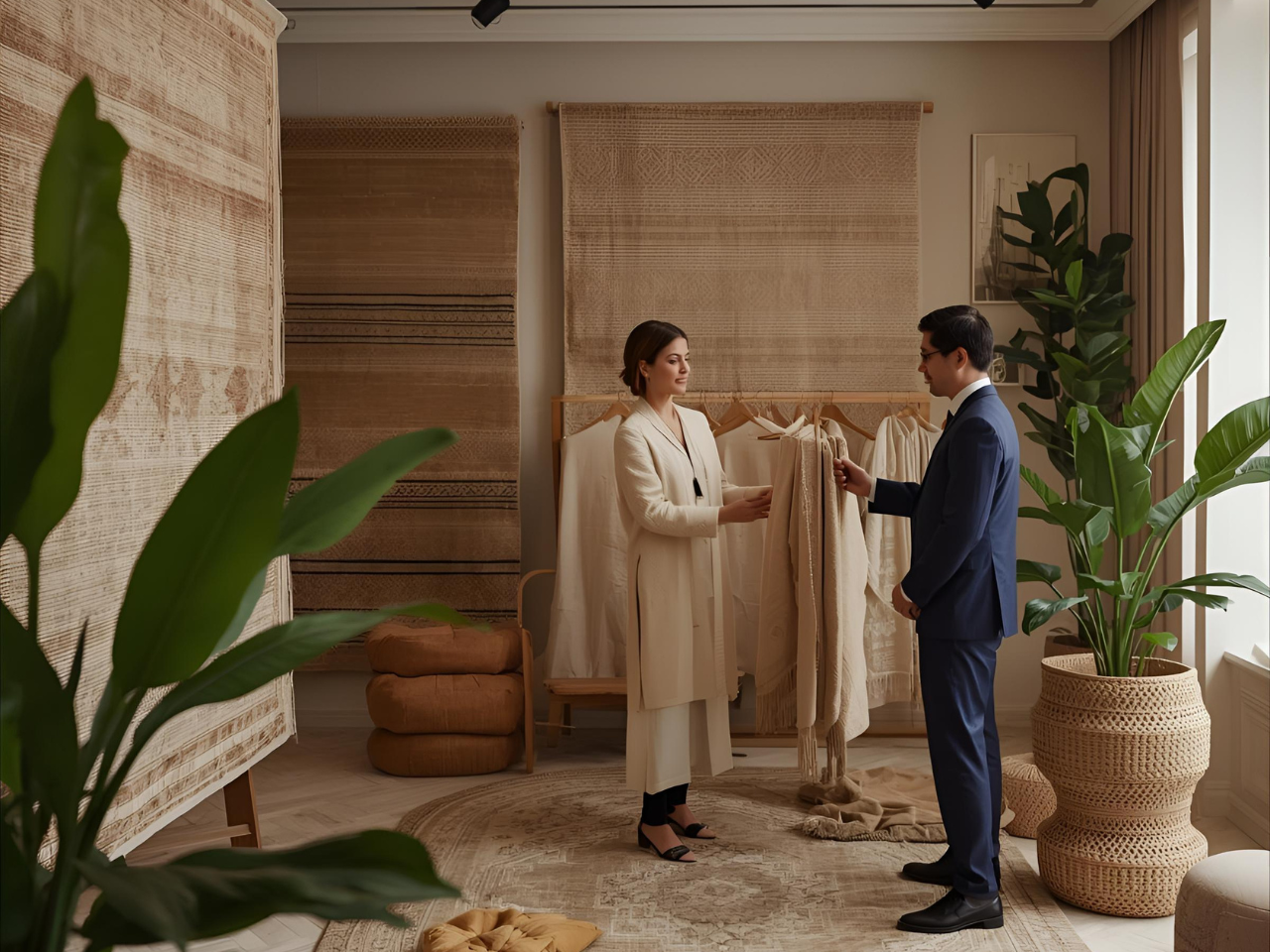A single rug can transform a living room from ordinary to extraordinary. Interior designers understand this power better than anyone—they know that the right rug doesn’t just cover the floor; it anchors the entire design scheme, defines zones within open-plan spaces, and sets the mood for years to come.
But here’s the question that both aspiring designers and homeowners often ask: where do interior designers buy rugs? The answer isn’t as straightforward as you might think. Professional designers have cultivated a network of trusted sources, from exclusive trade showrooms to artisan workshops, each offering unique advantages for different projects.
This comprehensive guide reveals the insider secrets of interior designer rug sourcing, exploring where professionals find those statement pieces that make spaces unforgettable. Whether you’re a designer building your supplier network or a homeowner seeking designer-quality rugs, understanding these sourcing strategies will elevate your approach to rug selection.
What Interior Designers Look for When Buying Rugs
Before diving into sourcing locations, it’s essential to understand the criteria that guide professional rug selection. Interior designers don’t simply choose rugs based on aesthetics alone—they evaluate multiple factors that ensure both immediate impact and long-term satisfaction.
Quality and craftsmanship top the list of designer priorities. Professionals examine construction methods, knot density, and finishing details that indicate durability and value. Hand-knotted rugs, for instance, offer superior longevity compared to machine-made alternatives, making them worthwhile investments for high-traffic areas.
Material preference plays a crucial role in selection decisions. Wool rugs provide excellent durability and natural stain resistance, while silk adds luxurious sheen for formal spaces. Jute and natural fibers work beautifully in casual, eco-conscious designs, and viscose offers silk-like appearance at accessible price points.
Color, pattern, and texture alignment with the overall design theme requires careful consideration. Designers often work with neutral foundations that allow flexibility in future updates, while bold patterns serve as statement pieces in carefully planned schemes.
Customization options become particularly important for unique spaces or specific client requirements. Many designers prefer suppliers who offer custom sizing, color modifications, or completely bespoke designs that perfectly match their vision.
Durability and maintenance needs factor heavily into recommendations, especially for family homes or commercial spaces. Designers consider foot traffic patterns, cleaning requirements, and lifestyle factors when making material and construction recommendations.
Where Do Interior Designers Buy Rugs: Top Sources
Professional designers typically source rugs through multiple channels, each offering distinct advantages for different project types and budgets.
Local Rug Boutiques & Showrooms
Physical showrooms remain essential for many designers who value the tactile experience of rug selection. Touching fibers, examining construction details up close, and seeing how colors appear under different lighting conditions provides insights that online shopping cannot match.
Local boutiques often specialize in specific styles or regions, allowing designers to develop expertise in particular categories. These relationships frequently extend beyond simple transactions—showroom staff become trusted advisors who alert designers to new arrivals and upcoming collections.
Luxury showrooms like those found in major design districts offer curated selections from prestigious manufacturers. In India, showrooms such as The Ambiente in New Delhi provide hands-on experiences where designers can examine traditional craftsmanship techniques while exploring contemporary designs.
Online Rug Marketplaces
Digital platforms have revolutionized interior designer rug sourcing by providing access to global collections and streamlined comparison shopping. Professional designers appreciate the ability to quickly filter by size, color, material, and price range across multiple brands simultaneously.
Reputable online platforms offer high-resolution imagery, detailed specifications, and often provide material samples upon request. This combination allows designers to pre-screen options before making showroom visits or placing orders.
The convenience of online browsing enables designers to source rugs for multiple projects simultaneously, comparing options across different price points and styles. Many platforms also offer professional programs with trade pricing and enhanced customer service.
Direct from Artisans or Manufacturers
Working directly with artisans or manufacturers appeals to designers seeking unique pieces or custom work. This approach often provides the best value for high-quality rugs while supporting traditional craftsmanship.
India’s rug-weaving regions, particularly Bhadohi and Kashmir, offer exceptional opportunities for direct sourcing. Many manufacturers now provide design consultation services, helping professionals create custom pieces that meet specific project requirements.
The rising trend of handcrafted Indian rugs gaining global recognition has made direct sourcing increasingly attractive. Designers can access traditional techniques like hand-knotting and natural dyeing while working with artisans to create contemporary designs.
Trade-Only or Designer Programs
Exclusive B2B programs cater specifically to interior design professionals, offering benefits unavailable to retail customers. These programs typically include significant trade discounts, early access to new collections, and custom ordering capabilities.
Many suppliers provide dedicated account managers for trade customers, streamlining the specification and ordering process. Extended payment terms and bulk pricing make these programs particularly valuable for larger projects.
Professional programs often include educational resources, trend forecasting, and design support services that help designers stay current with evolving styles and client preferences.
Benefits of Buying from Premium Indian Rug Brands
Indian rug craftsmanship has earned international recognition for its exceptional quality and artistic heritage. Designers increasingly turn to Indian manufacturers for both traditional and contemporary pieces that offer superior value.
Hand-knotted construction techniques passed down through generations create rugs with unmatched durability and character. Traditional methods using natural dyes produce colors with depth and richness that synthetic alternatives cannot replicate.
Many Indian rug brands now focus on sustainable and ethical production practices, appealing to environmentally conscious designers and clients. Fair trade partnerships and women’s empowerment initiatives add meaningful stories to beautiful products.
Brands like The Ambiente exemplify this evolution, combining 30+ years of manufacturing expertise with contemporary design sensibilities. Their work with over 4,000 women weavers creates economic opportunities while preserving traditional skills.
The design consultation services offered by premium Indian brands help professionals navigate customization options and technical specifications. This expertise proves invaluable when creating rugs for specific architectural requirements or client preferences.
Budget Considerations for Designers and Homeowners
Successful rug sourcing requires clear budget parameters that balance quality aspirations with financial realities. Setting specific budget ranges before beginning the search helps narrow options and prevents scope creep during selection.
Quality materials and construction represent long-term investments that often prove more economical than frequent replacements of lower-grade alternatives. Wool rugs, while initially more expensive than synthetic options, provide decades of beauty with proper care.
Custom rugs require careful budget planning that accounts for design development, production timelines, and potential modifications. Working within established parameters helps maintain project profitability while achieving design goals.
Maintenance and cleaning costs vary significantly by material and construction method. Factoring these ongoing expenses into initial budget calculations provides a more accurate total cost of ownership.
Seasonal sales and promotional opportunities can provide significant savings on high-quality rugs. Developing relationships with suppliers often leads to advance notice of upcoming sales events.
Professional Tips for Effective Rug Sourcing
Successful interior designer rug sourcing requires systematic approaches that ensure both aesthetic success and client satisfaction.
Match rug style with space layout by considering architectural elements, furniture placement, and traffic patterns. Open floor plans may require larger rugs that define conversation areas, while smaller spaces benefit from rugs that complement rather than compete with other design elements.
Use rug size and placement strategically to create visual zones within larger spaces. In dining areas, rugs should extend beyond chair placement to maintain functionality. Living rooms benefit from rugs that anchor seating arrangements while allowing traffic flow.
Request material swatches or samples before making final selections, especially for custom or high-value purchases. Seeing materials under project lighting conditions prevents costly mistakes and ensures color coordination.
Partner with reliable suppliers who provide consistent quality, meet delivery timelines, and offer post-sale service. Establishing these relationships creates valuable resources for future projects and client referrals.
Frequently Asked Questions
How much should interior designers budget for quality rugs?
Professional-grade rugs typically range from $15-50 per square foot for machine-made options, while hand-knotted rugs can range from $50-300+ per square foot depending on materials and craftsmanship. Custom pieces often command premium pricing but provide unique design solutions.
What’s the difference between hand-knotted and hand-tufted rugs?
Hand-knotted rugs feature individual knots tied to create the pile, resulting in superior durability and value retention. Hand-tufted rugs use a tufting gun to push yarn through a canvas backing, creating good quality at more accessible price points.
How long do custom rugs take to produce?
Custom rug production typically requires 8-16 weeks depending on size, complexity, and construction method. Hand-knotted pieces may require several months for larger sizes or intricate patterns.
Should designers always see rugs in person before purchasing?
While physical inspection is ideal, many successful designers work with trusted suppliers who provide accurate samples and detailed specifications. Establishing relationships with reliable sources enables confident remote purchasing for appropriate projects.
What certifications should designers look for in quality rugs?
Look for certifications like GoodWeave (child labor-free), GREENGUARD (low emissions), and care labels that indicate proper maintenance procedures. These certifications ensure ethical production and long-term performance.
Transform Spaces with Expert Rug Selection
Understanding where interior designers buy rugs opens doors to exceptional pieces that transform ordinary spaces into extraordinary environments. From local showrooms offering tactile experiences to online platforms providing global access, each sourcing channel offers unique advantages for different project requirements.
The key to successful rug sourcing lies in building relationships with trusted suppliers who understand professional needs and quality standards. Whether working with local boutiques, direct artisan partnerships, or trade-exclusive programs, consistency in service and product quality creates the foundation for long-term design success.
Indian rug craftsmanship continues to set global standards for quality, creativity, and value. Brands combining traditional techniques with contemporary design sensibilities offer designers access to pieces that honor heritage while meeting modern lifestyle demands.
Ready to discover handcrafted rugs that elevate your design projects? Explore The Ambiente’s curated collection of premium handmade rugs, where 30+ years of craftsmanship expertise meets contemporary design innovation. From ready-to-ship options to fully custom creations, find the perfect foundation for your next inspired space.
Related Blogs:





